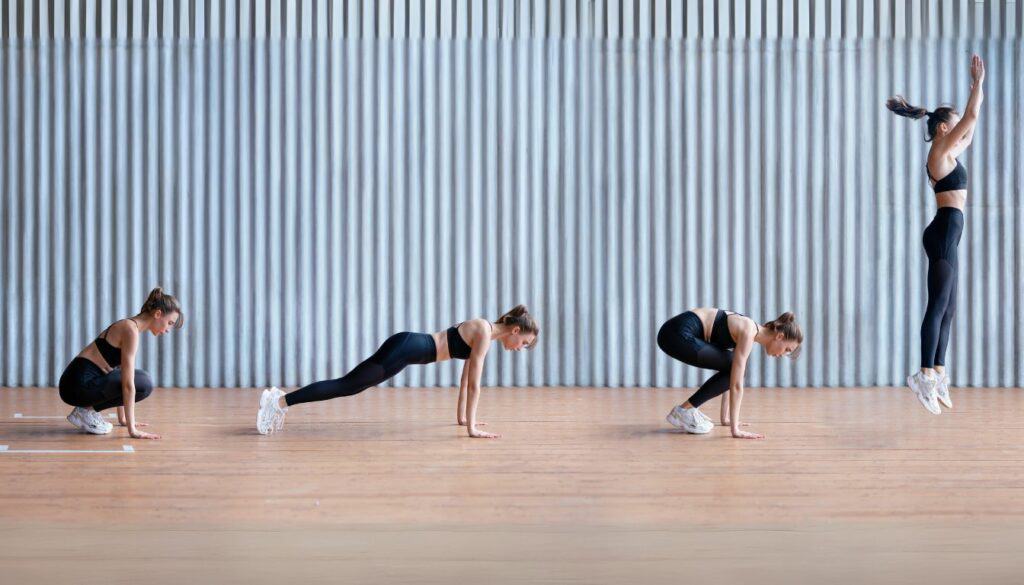Are you looking for a way to maximize your workout while still having enough time in the day for all your other activities? Look no further than HIIT, or high-intensity interval training.
This type of workout involves short bursts of intense exercise followed by brief rest periods or active recovery. And the best part? A 20-minute HIIT session can be just as effective, if not more so, than a longer workout.
HIIT has become increasingly popular due to its efficiency and effectiveness. Not only does it burn calories and build muscle, but it also improves endurance and cardiovascular health. Plus, with various exercises and modifications available, it can be tailored to fit any fitness level or preference.
So why spend hours at the gym when you can see results in just 20 minutes with HIIT? Let’s dive deeper into what makes this type of workout so effective and how you can get started today.
Key Takeaways

- HIIT is an effective way to maximize workout time, with a 20-minute session as effective as a longer workout.
- Short bursts of intense exercise followed by rest or active recovery in HIIT can burn calories, build muscle, and improve endurance and cardiovascular health.
- HIIT can be tailored to fit any fitness level or preference and can be done at home without special equipment.
- Recovery techniques such as stretching or foam rolling are crucial for HIIT workouts to prevent fatigue, injury, or decreased performance.
Understanding HIIT and How it Works
If you’re looking for a workout that can torch calories and get your heart pumping, HIIT (High-Intensity Interval Training) might be the answer – it’s like a sprinter compared to a long-distance runner.
HIIT involves short bursts of intense exercise followed by periods of rest or lower-intensity activity. This type of training has gained popularity in recent years due to its numerous benefits, including improved cardiovascular health, increased metabolism, and fat loss.
Despite its effectiveness, there are still some misconceptions about HIIT. One common myth is that it’s only suitable for experienced athletes or those in peak physical condition. However, HIIT workouts can be modified to suit any fitness level, making it accessible to everyone.
Another misconception is that longer workouts are always better than shorter ones – but studies have shown that just 20 minutes of HIIT can provide significant health benefits compared to longer bouts of steady-state cardio.
With these facts in mind, let’s explore the many benefits of HIIT.
Benefits of HIIT

You’ll love the benefits of HIIT, from improving your cardiovascular health to increasing your metabolism and burning fat. High-Intensity Interval Training (HIIT) is a great way to achieve these results in less time than traditional exercise methods. The intensity of HIIT helps you burn more calories in less time and keeps your body working even after your workout has ended.
However, it’s important to remember that recovery is just as crucial as the workout. You may experience fatigue, injury, or decreased performance without proper rest and recovery. Active recovery techniques such as stretching or foam rolling can help prevent injuries and improve flexibility.
So, prioritize both the workout and recovery aspects when incorporating HIIT into your fitness routine. Now, let’s dive into how effective a 20-minute HIIT workout can be for achieving these benefits!
The 20-Minute HIIT Workout
Now, let’s get into how you can fit a powerful HIIT workout into your busy schedule with just 20 minutes of high-intensity exercise. The beauty of HIIT is that it doesn’t require fancy equipment or gym membership. All you need is a timer and some space to move around. However, if you do have access to HIIT equipment, such as kettlebells or resistance bands, feel free to incorporate them into your routine for an added challenge.
To maximize your 20-minute HIIT workout, consider making modifications based on your fitness level and personal preferences. For example, if you’re new to HIIT, start with shorter intervals and longer rest periods until you build up your endurance. On the other hand, if you’re already familiar with HIIT and want to push yourself further, try increasing the intensity by shortening the rest periods or adding more challenging exercises to your routine.
Incorporating these modifications will help prevent injury and keep things interesting and challenging for both your mind and body. With just 20 minutes of high-intensity exercise using these tips, you’ll be well towards achieving your fitness goals.
Now let’s dive into how HIIT can help burn calories without sacrificing muscle mass.
HIIT and Calorie Burning

Sure, you don’t want to lose muscle mass while trying to burn calories, but who says you can’t enjoy a high-intensity workout that makes it fun? HIIT is one such workout that helps you shed those extra pounds through a calorie deficit and increases your metabolic rate.
HIIT involves performing short bursts of intense exercise followed by active recovery periods. This training keeps your body burning calories for hours after the workout and helps increase your metabolic rate. A higher metabolic rate means your body burns more calories even when you’re at rest, making it easier to maintain a calorie deficit and reach your weight loss goals.
So go ahead and give HIIT a try – it’s an effective way to burn calories without sacrificing muscle mass.
Speaking of muscle mass, did you know that HIIT can also help build muscle? Find out how in the next section about ‘HIIT and Muscle Building.
HIIT and muscle-building
Get ready to see some amazing results when you incorporate HIIT into your workout routine, as this type of training can help you burn calories and build muscle. HIIT is a great way to increase muscle mass while keeping your heart rate up and burning fat.
Here are three ways HIIT can help you build muscle:
- HIIT uses compound exercises, which work multiple muscles at once. This means you get more bang for your buck with each exercise, and your entire body is being worked out.
- By incorporating resistance training into your HIIT workouts, you’ll be able to challenge your muscles even more and promote growth.
- HIIT also helps prevent injury by improving the strength of the stabilizing muscles in your body.
In addition to building muscle, HIIT is also an effective method for weight loss. The combination of high-intensity intervals and active recovery periods keeps your metabolism elevated long after the workout, meaning you’ll continue to burn calories throughout the day. So not only will you be building muscle with HIIT, but you’ll also see improvements in overall body composition.
As you continue on your fitness journey, it’s important to remember that endurance plays a crucial role in achieving optimal health and fitness levels. So let’s now discuss how incorporating endurance training into your routine can take your workouts to the next level without sacrificing any gains made through HIIT workouts!
HIIT and Endurance Training

You’ll be amazed at how incorporating endurance training into your routine can take your workouts to the next level while continuing to see the benefits of HIIT. While HIIT is great for burning calories and building muscle, it’s important not to neglect endurance training. The two types of exercise complement each other and provide different benefits.
Endurance benefits extend beyond simply being able to run longer distances. Endurance training also improves cardiovascular health, increases oxygen uptake, and enhances cell energy production. When comparing HIIT and steady-state cardio, both are effective forms of endurance training but offer different advantages. Steady-state cardio focuses on sustained physical activity at a moderate intensity over a prolonged period. HIIT involves short bursts of high-intensity activity followed by periods of rest or low-intensity activity. Incorporating both into your workout routine can help you achieve overall fitness balance.
As you transition into learning about HIIT for beginners, remember that incorporating endurance training can further enhance your progress toward a healthier lifestyle. By challenging yourself with different forms of exercise, you’ll continue to break through plateaus and reach new heights in your fitness journey.
HIIT for Beginners
If you’re new to high-intensity interval training, it’s important to start slowly and gradually build up your endurance. HIIT workouts are designed to challenge even the most experienced athletes, so beginning with shorter intervals and lower intensity levels is critical. As you progress, you can increase the length of your intervals and add more challenging exercises.
One of the great things about HIIT is that it requires no special equipment. You can do a HIIT workout at home using just your body weight or incorporate equipment like dumbbells or resistance bands for added resistance. However, it’s essential to take safety precautions when doing these types of exercises. Ensure you have proper form and technique before adding any weight, and always warm up before beginning your workout. Remember: safety first!
As important as it is to push yourself during a HIIT workout, rest and recovery are just as crucial for achieving optimal results. Without adequate rest between workouts, you risk overtraining, which can lead to injury or burnout.
The next section will discuss how taking time off from exercise is essential for allowing your muscles time to repair and grow stronger.
The Importance of Rest and Recovery
Now that you’ve started incorporating HIIT into your fitness routine, it’s important to understand the importance of rest and recovery.
While HIIT can be incredibly effective, it’s important to give your body time to recover in between sessions.
This discussion will explore how often you should do HIIT and why rest and recovery are crucial for achieving your fitness goals.
How Often Should You Do HIIT?
To maximize the benefits of HIIT, it’s recommended that you incorporate it into your fitness routine at least 2-3 times per week. The frequency of your workouts should depend on your fitness level and goals.
If you’re a beginner, start with two weekly sessions and gradually increase as your body adapts to the intensity. For advanced athletes, three or more weekly sessions may be necessary to continue seeing progress.
When planning your HIIT schedule, remember to balance the intensity of each workout with proper rest and recovery time. Overtraining can lead to injury and burnout, so it’s important to give yourself adequate rest days between workouts.
In addition, incorporating stretching and foam rolling into your routine can help prevent muscle soreness and improve flexibility. By balancing frequency and recovery, you can make the most out of each HIIT session and achieve optimal results in no time!
And now let’s talk about why taking rest days is crucial for any exercise routine…
Importance of Rest and Recovery
You may think that pushing yourself to the limit daily is the key to success, but rest and recovery are crucial components of any exercise routine. In fact, neglecting these aspects can lead to injury and burnout, which will ultimately hinder your progress rather than enhance it.
Resting strategies are important for allowing your body time to repair and rebuild after a tough workout. This includes getting enough sleep each night, taking rest days throughout the week, and incorporating low-intensity activities such as yoga or stretching.
Recovery techniques like foam rolling or massage can also aid in reducing muscle soreness and improving flexibility. Remember, taking care of your body through proper rest and recovery is just as important as pushing yourself during a high-intensity workout.
Conclusion
Congratulations! You’ve made it to the end of this article on the effectiveness of 20 minutes of HIIT. By now, you should understand what HIIT is, how it works, and the benefits it can provide.
Think of your body as a car – HIIT is like a turbo boost that kicks in when you need that extra burst of energy. It’s efficient, effective, and can take your fitness to the next level in just 20 minutes.
HIIT has got you covered whether you’re looking to burn calories, build muscle, or improve endurance. So, try HIIT if you’re ready to rev up your engine and transform your body with only 20 minutes a day.
Remember to start slow and gradually increase intensity as needed. And most importantly, don’t forget to rest and recover properly to continue pushing yourself toward your fitness goals without burning out.
With dedication and consistency, there’s no limit to what you can achieve with HIIT – so why not begin your journey today?
As a veteran fitness technology innovator and the founder of GearUpToFit.com, Alex Papaioannou stands at the intersection of health science and artificial intelligence. With over a decade of specialized experience in digital wellness solutions, he’s transforming how people approach their fitness journey through data-driven methodologies.
